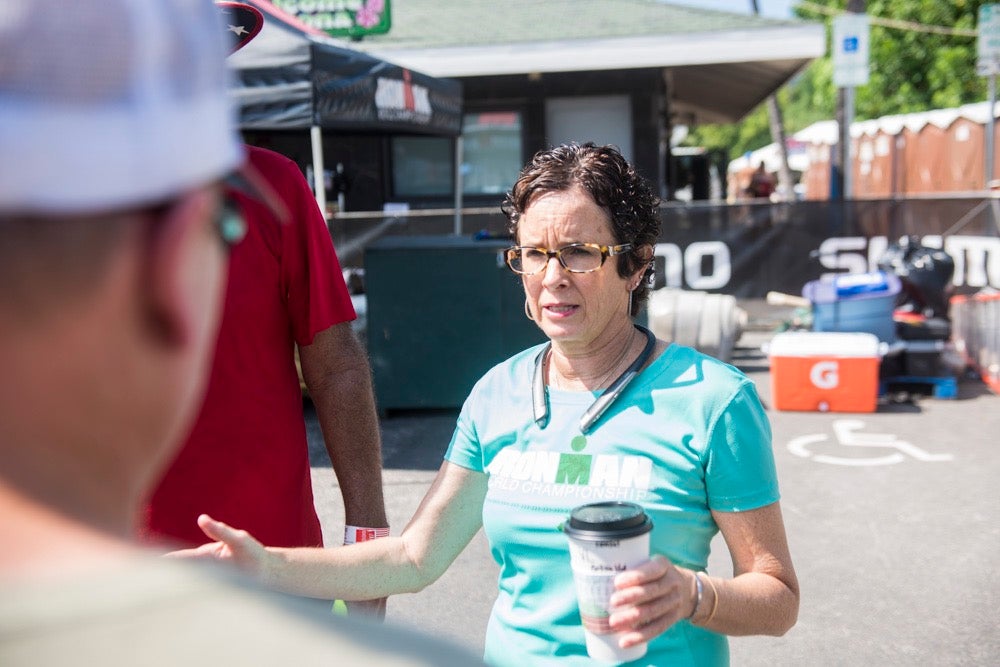Characters of Kona: IMWC Race Director Diana Bertsch

Ironman World Championship Race Director Diana Bertsch. Photo: Corey Hollister
In order to give readers a unique perspective of this year’s Hawaii Ironman, we’re going to look at some of the essential pieces that make this event special. Each day, Triathlete.com will feature one of the Characters of Kona—be it a person, a group of people, or even a place—that makes the Ironman World Championship completely different from every other triathlon in the world. These are the parts of Hawaii Ironman that make it insanely difficult, incredibly inspiring, and totally singular.
It’s the Thursday before Hawaii Ironman World Championships, and the iconic transition area is still more parking lot than hallowed triathlon ground. It’s almost impossible to visualize this same spot as the center of the triathlon universe in less than 44 hours when the first cannon fires and the pro men begin likely the longest day of their season. But there’s one person who has the best view of it all, from the highest vantage point in Kona: race director Diana Bertsch.
If the Hawaii Ironman World Championships has a central nervous system, it exists within the roughly 5’4” frame of this razor sharp woman with tight cropped hair and tortoise shell eyeglasses. Bertsch has been the race director of the most important race in the sport for 14 years (this will mark her 15th year as race director, she was also race assistant from 1997-2000). A resident of nearby Holualoa, she’s fond of quoting Hawaiian sayings and fully subscribes to the “aloha spirit,” as she puts it.
She walks the entirely unfinished transition area with a sense of urgency, but not a hint of panic. She holds rapid-fire standup meetings with coordinators from every department; it’s a moving piece of machinery, but she clearly has both hands on the wheel at all times. For Bertsch, being in control means 18-20 hours of work per day on race week—but you wouldn’t know it. She shrugs off any hint of fatigue by citing the adrenaline that comes with the buzz of the job; she’s also quick to point out that there are countless volunteers that work the same hours as she does.
She says hi to everyone and greets most with a hug. She yells across the asphalt to a high-level coordinator to “take care of” a smiling dark bronze-skinned Hawaiian volunteer opening and closing the gate (“Let’s get him a t-shirt right away.”). Bertsch waves to the garbage truck driver and asks him about his father. She talks with pride about how she has a volunteer who’s worked the event for 38 years—a volunteer that could have watched Julie Moss crawl across the finish line and Kathleen McCartney pass her in the final few hundred meters back in 1982. Less than a minute into her walk-through at the venue, McCartney herself walks up and gives Bertsch a hug.
While her passion for the history and culture of the event is obvious, Bertsch concedes that there have been a few changes during her 15-year tenure: not just the scale of the race (1,570 finished in her first year, 2,207 finished last year) but the scope of the events surrounding actual race day itself. Aside from the logistical superlatives on October 14, there are now 20 events going on around the nine days, anchored by the race itself.
And yet Bertsch is a constantly moving target. Whether she’s fielding phone calls, texts, or questions about the space between bike racks (fitting over 2,000 of the best triathletes in the world onto an incredibly tiny pier/parking lot/transition area is like trying to solve a Rubik’s Cube with photochromic squares), she’s fully conscious of the weight of her position. Bertsch knows that this is no regular race—despite how comforting that illusion might be, in order keep the pressure at bay. She knows it’s a world championship event, and she’s proud of it (“These athletes deserve a world-class experience.”).
So when you tune into this slick, immaculately organized event on Saturday—or when you’re treading water waiting for the cannon—bear in mind that there’s someone whose 10,000-foot view has helped conduct this whole iconic triathlon symphony.